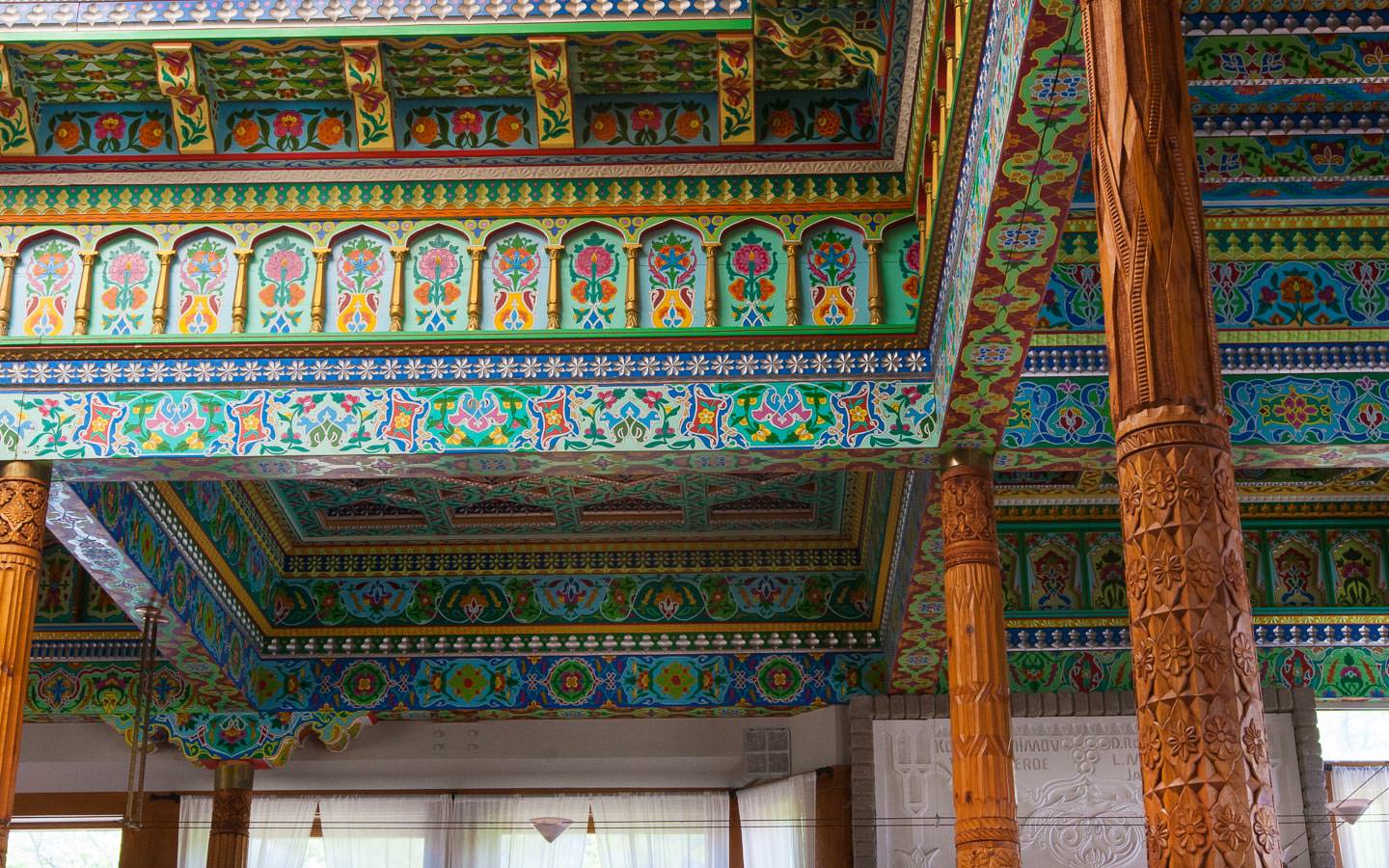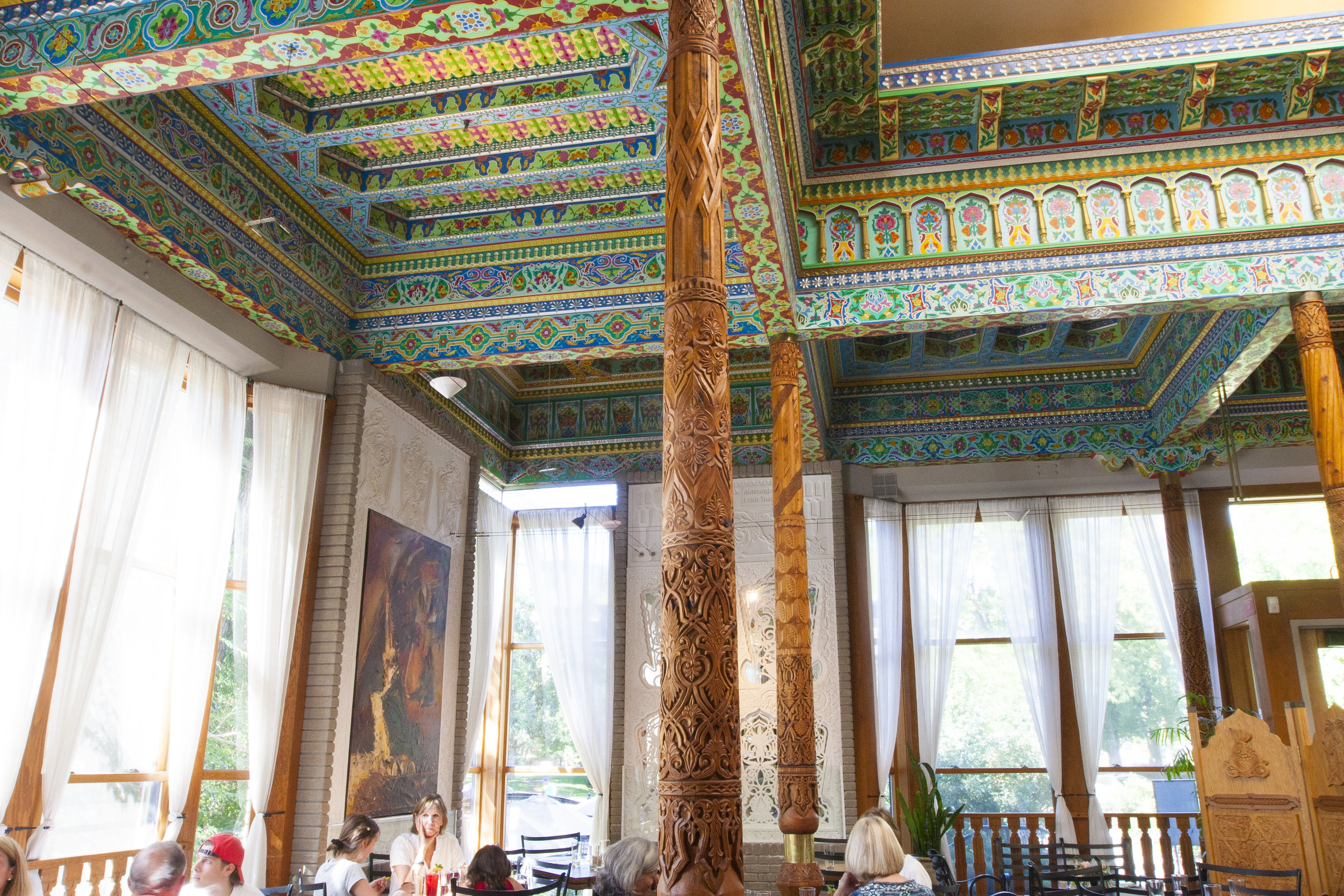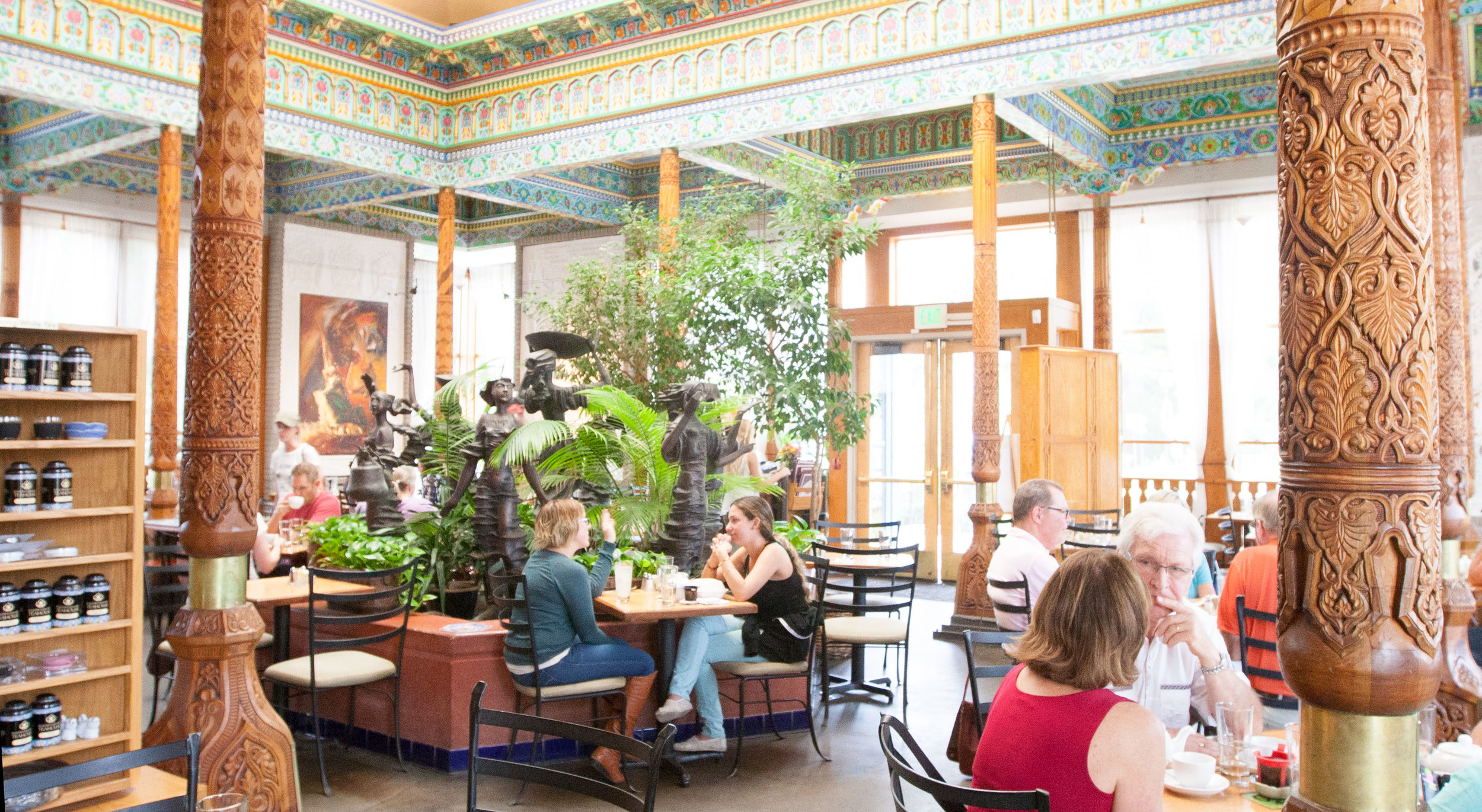The Story of the Teahouse
THE HiSTORY
In 1987, during his first visit to Boulder, Mayor Maksud Ikramov announced that Dushanbe planned to present our city with a Teahouse to celebrate the establishment of sister city ties. From 1987 -1990, more than 40 artisans in several cities of Tajikistan created the decorative elements our Teahouse, including its hand-carved and hand-painted ceiling, tables, stools, columns, and exterior ceramic panels. Often these skills are handed down from generation to generation within families. Lado Shanidze served as chief architect.
Our Teahouse accurately reflects this artistic tradition that dates back nearly 2,000 years. The master woodcarvers, including Manon Khaidarov and Mirpulat Mirakhmatov who helped reassemble the Teahouse here, have carved their names in the ceiling.
In Central Asia, teahouses serve as gathering places where friends meet to talk or play chess over a cup of tea. Many teahouses are traditionally decorated with Persian art, characterized by the use of motifs from nature – stellar, solar, and floral, by the repetition of patterns, by form over representation and pattern over detail, and by lavish decoration and color. Our Teahouse accurately reflects this artistic tradition that dates back nearly 2,000 years. The master woodcarvers, including Manon Khaidarov and Mirpulat Mirakhmatov who helped reassemble the Teahouse here, have carved their names in the ceiling. The artisans who have painted it have written their names on a green painted area above the entry to the kitchen. A message carved in the ceiling reads “artisans of ancient Khojand whose works are magical”.
ColorFul Ceramic Panels
Eight colorful ceramic panels, created by Victor Zabolotnikov, grace the building’s exterior and display patterns of a “Tree of Life” enclosed by a mihrab motif (a niche in a mosque indicating the direction of Mecca.) Each panel was sculpted in Tajikistan, cut into smaller tiles, fired, and then carefully packed to be sent to the USA. Once here, they were repositioned together by Victor, who was visiting to help with construction. Inside the Teahouse are eight large, intricately carved white plaster panels, designed and executed by Kodir Rakhimov, whose contemporary oil paintings are framed by this art of Persian antiquity. The central pool features seven hammered copper sculptures by Ivan Milashevich, based on a 12th century poem, “The Seven Beauties”, in which a princess from each of seven different nations narrates a fable that expresses important cultural values.
Teahouse Interior
The Painted & Carved Ceiling
The ceiling of the Teahouse was carved and painted with intricate patterns traditional of Persian Art. The teahouse ceiling was originally built, carved and painted in Tajikistan. Absolutely no power tools were used in the original construction. The work was crafted by hand exactly as it was centuries ago. Inside the Teahouse, there are 12 intricately carved cedar columns. These, were sent from Tajikistan with the original gift. No two columns are alike.
THE CARVED PLASTER PANELS
Intricately carved plaster panels, by Kodir Rhakimov, demonstrate the ancient art of Persian Ganch. Kodir’s oil paintings provide an interesting combination of style and era by juxtaposing the contemporary style of Soviet art with the ancient mediums of the Persian Empire.
Kodir carved the ganch during his visit to Boulder, and it took many months to complete the job. First, Kodir mixed his secret blend of plaster, allowing it to cure to a specific consistency. Then he placed it on an easel and began the painstakingly slow process of carving the delicate material. Each panel is composed of a number of “tiles” that when put together create the whole. After the panels were installed in the Teahouse, Kodir spent another month and a half perfecting his work.
THE SEVEN BEAUTIES
“The Seven Beauties is the 4th poem of Nizami Ganjavi’s “Khamsa, which means “Five Treasuries”. The works were completed in 1197 ad, and chronicle the adventure of Shah Bahram Goirr, son of Yargourd the 1st from the Sasanids dynasty. Nizami uses the well documented events to explore the themes social justice, morality, and appreciation of nature. The poem is notable for its deep content and social sense, as well as its rich composition and prominent poetic value.
In the middle ages, the number “SEVEN” was considered a sacred number. Both mythological and scientific beliefs of the day held that the world was divided into seven countries, there are seven planets, weeks are divided into seven days, and the spectrum is composed of seven colors.
In his youth, our hero sees portraits of the seven daughters of the continents in a luxurious palace loses his heart to them. Later, when he becomes the Shah of Iran, he sends for the seven women and marries them. He has the renown architect, Shidda, build a palace with seven cupolas, each colored a different color with a corresponding planet. On the proper day of the week, Bahram would dress himself in the appropriate color, and go to visit the wife that corresponded with the day. Each woman would relate to him a story from her native land and praise the attributes of her own color. All the tales are closely related to popular folklore and combine the scientific and philosophical views on the symbolic effects of the colors. The poem inspires honesty, virtue and kindness, while denouncing arrogance, villiany, greediness and treachery. And so, the princesses’ tales serve not only to entertain the Shah, but to ponder life and consider the secrets on the universe and human nature.
In the central pool of the Teahouse there are seven hammered copper sculptures created by artist Ivan Milosovich. The life sized sculptures are based on a 12th century poem, “The Seven Beauties ” the 4th poem of Nizami Ganjavi’s “Khamsa”. The poems were completed in 1197 ad. They chronicle the adventures of Shah Bahram Goirr, son of Yargourd the 1st from the Sasanids dynasty. Nizami uses the well documented events to explore the themes of social justice, morality, and appreciation of nature. The poem is notable for deep content and social sense, as well as rich composition and prominent poetic value.
TAJIKISTAN
In the 7th Century BC, the area we now know as Tajikistan was settled at the eastern periphery of the Persian Empire. Situated a bit south of the Silk Road trails, the area has seen invasions by Alexander the Great, Mongols, Arabs, Turks, and Russians. Today, Tajikistan, with a population of 7 million, is about the size of Iowa, and is bordered to the east by China, to the north by Uzbekistan and Kyrgystan, and to the south by Afghanistan. At the western end of the Himalayas, its terrain is 93% mountainous, with peaks towering to 24,000 feet. The Tajik language is like Persian. Prior to being named capital to the Soviet Republic of Tajikistan in 1929, Dushanbe, which signifies Monday, was a village of 400 – 600 people and was the site of the weekly bazaar, held on Mondays. Dushanbe now has a population of 600,000 and its people are struggling with the aftermath of civil war following the collapse of the Soviet Union in 1991.
Dushanbe
Dushanbe {doo-shan-bay’} is the capital of Tajikistan. The name, meaning “Monday,” is derived from the day of the week on which a bazaar was held in the village on the site. The original village of Dushanbe was chosen in 1924 as the capital of the Tajik Autonomous Soviet Socialist Republic within the USSR. In 1929 it became capital of the Tajik SSR and was renamed Stalinabad. In 1961, during the de-Stalinization period, the city reassumed its original name. With the dissolution of the Tajik SSR in 1991, it became the capital of an independent Tajikistan.
Land & Resources
Ninety-three percent of Tajikistan’s territory is mountainous, and almost half of the republic lies at an elevation greater than 9000 ft. The Pamir Mountain Range in east-ern Tajikistan contains the highest mountain in the former USSR, at 7498 m (24,599 ft). Great contrasts in temperature exist between alpine and lowland areas. While the average daily temperature in July is greater than 31° C (87.8° F) in the valleys, it is less than 10° C (50° F) in the mountains. Wildlife is extremely varied and includes the endangered snow leopard as well as numerous varieties of mountain goat and sheep, including the Siberian horned goat and the rare markhor.
Boulder-Dushanbe Sister Cities Project
The Boulder Dushanbe Teahouse would not have been possible without the continued support of the Boulder-Dushanbe Sister Cities Project.
Boulder-Dushanbe Sister Cities is a non-political, all-volunteer, not-for-profit organization (incorporated as a 501(c)(3) corporation under U.S. tax laws).
Membership is open to anyone sharing our goal of friendship , understanding and communication between the peoples of the United States and Tajikistan.
Boulder’s Sister Cities program is made up of volunteers who believe that through mutual respect and cooperation, people worlds apart can form relationships that foster peace and prosperity. We believe that it’s possible to make big changes from small steps.
To Learn More about BDSC visit HERE
To learn more about Sister Cities International visit their web page HERE .








